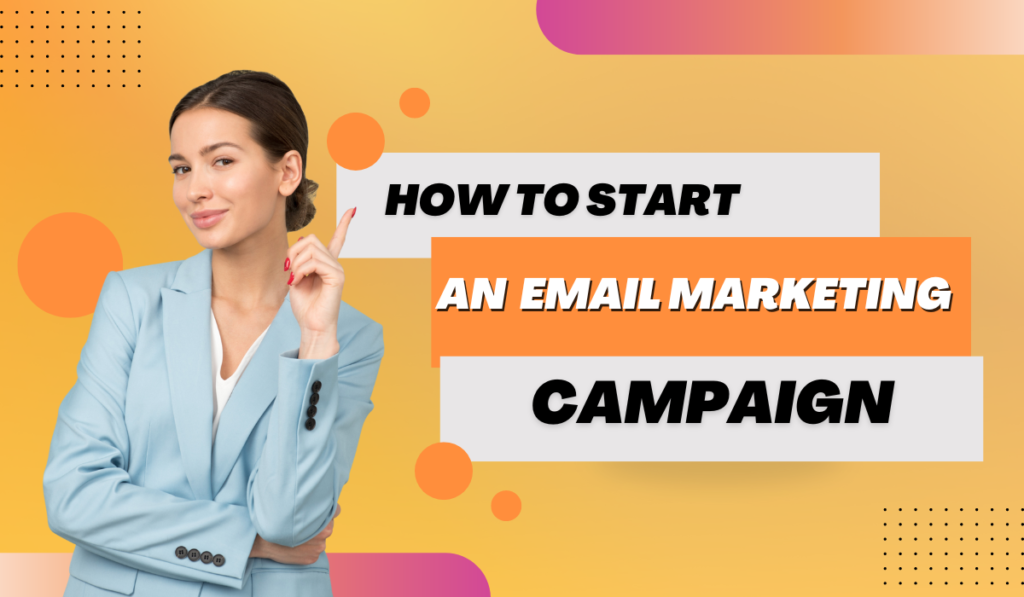Introduction
Email marketing is a crucial component of your marketing strategy, enabling you to connect directly with customers on your email list. It serves multiple strategic purposes, such as attracting new customers who may be more inclined to share their email address initially than to make an immediate purchase.
This digital marketing channel plays a pivotal role in nurturing relationships with current customers, ensuring your brand stays top-of-mind between transactions. Additionally, it excels in customer education, demonstrating why your brand is their ideal choice, and in enhancing brand visibility among both potential and existing customers. Importantly, email marketing achieves all these objectives cost-effectively, making it a highly efficient means to engage with a broad audience.
How To Start An Email Marketing Campaign
Choose a relevant email list
Choose a relevant email list to maximize the effectiveness of your campaigns. For instance, if you’re promoting a special Diwali discount exclusively available in India, ensure it reaches your Indian subscribers. Segmenting based on geographical location ensures that your emails are targeted precisely to those who can benefit from the offer. Avoid unethical practices like purchasing email lists, as this not only harms your engagement and conversion rates but also risks being flagged as spam by email service providers (ESPs). It’s crucial to build your email list organically to maintain trust and deliver value to your subscribers.
Design your email
Your email’s impact depends not only on its content but also on its visual appeal. Here are key tips to craft an engaging email design:
- Integrate your branding: Incorporate your logo, utilize brand colors and fonts consistently, ensuring your design reflects your visual identity.
- Incorporate white space: Allow your email content room to breathe by strategically using white space around text and visuals. This enhances readability and gives your design a polished, professional appearance.
- Utilize multimedia: To avoid a text-heavy appearance, include images and GIFs that enhance visual interest. For instance, a vibrant header image can immediately capture attention.
- Ensure responsiveness: Optimize your emails to display well on both desktop and mobile devices. Avoid using oversized images that may not load properly on smaller screens or slower connections.
- Establish a clear visual hierarchy: Employ alignment, varying font sizes, and other design principles to guide recipients through your email’s content effectively.
Personalize your email subject line and content
Personalizing your email subject line and content is key to engaging your subscribers on a personal level. It involves leveraging subscriber data to customize your email’s subject line, content, or design for each individual contact, making your emails feel more relevant and meaningful.
Here are effective ways to personalize your emails:
- Capture attention by addressing the subscriber by name in the subject line.
- Offer regional specials or events according to the subscriber’s area.
- Recommend products tailored to their interests or previous purchases.
Be conversational
Consumers face a constant stream of marketing emails daily and are weary of overly promotional messages from brands and automated systems. To authentically connect with your subscribers and cultivate meaningful relationships, it’s crucial to communicate with them on a personal level, not just as another business interaction. This approach is fundamental in mastering “How To Start An Email Marketing Campaign.”
Keep your emails warm, approachable, and conversational. Address your subscribers in a friendly tone, as if you’re speaking to a familiar acquaintance. This approach naturally imbues your emails with a sense of personal connection and relatability, fostering higher engagement and ultimately boosting conversions.
Create follow-ups
Sometimes, a single email isn’t enough. To effectively nurture your subscribers and increase conversions, consider following up with a second or even a third email. This strategy gets used for a variety of email campaigns, like welcome series, advertising campaigns, and abandoned cart sequences.. For instance, here’s how you might structure an abandoned cart series to recover sales:
- Remind subscribers about their abandoned items and invite them to complete their purchase.
- Offer a discount coupon they can use during checkout to incentivize immediate action.
- Warn subscribers about the approaching end date of the goods that are in their bags to create an impression of anxiety.
Automating these email workflows is straightforward with marketing automation tools. Simply design your emails, set triggers based on subscriber behavior, define appropriate wait times between emails, and let the automation handle the rest.
Note that you need to find the right balance between being relentless and displaying consideration for your subscribers’ inboxes. Space out your follow-up emails appropriately and avoid overwhelming your audience with excessive emails, which could lead to unsubscribes or spam reports.
Send emails from a real person
Imagine receiving an email from “no-one@yourbusinesses.com.” Such a generic alias can make your email sound like just another automated message sent to a mass audience.
Avoid this by using a recognizable sender name in your email marketing campaigns. This approach not only increases the likelihood of your emails landing in subscribers’ inboxes but also helps convey a more personal and human touch. Consider using a name from your business, such as the founder or marketing manager — for instance, Justyn from Sprout — to establish a direct and personal connection with your audience. This simple tactic is a crucial step in mastering How To Start An Email Marketing Campaign.
A/B test your emails
There’s no such thing as the “perfect” email, but you can come close by testing your emails before sending them out.
Analyzing the results helps you identify which version performs better, allowing you to optimize the content before sending it to your full email list.
Testing not only enhances your campaign effectiveness but also provides valuable insights into your audience’s preferences and behaviors. This knowledge is instrumental in refining your email strategies and ultimately strengthening your business over time.
Follow email or spam regulations
Ignoring spam regulations is a surefire way to risk email bans and hefty fines. Honoring rules such as the CAN-SPAM Act and GDPR is important for keeping your audience’s confidence and keeping in compliance.
Essentially:
- Avoid purchasing email lists.
- Add people to your newsletter list only if they have given their clear consent.
- Clearly present privacy policy information
- Ensure unsubscribe links are prominently featured in your emails and promptly honor opt-out requests.
- Refrain from using deceptive language or misleading tactics in your emails.
- Include your physical mailing address information in every email footer for transparency and compliance.
The success of your email campaigns
One of the greatest advantages of email marketing, crucial in “How To Start An Email Marketing Campaign,” is the ability to continually monitor and enhance the performance of your campaigns. Most email marketing tools provide comprehensive analytics and dashboards to help you gauge the effectiveness of your efforts. This continuous feedback loop allows you to optimize your strategies, refine your content, and maximize engagement with your audience over time.
Here are some key metrics you should track across all your email campaigns:
Open rate: This metric indicates the average number of times your emails are opened. It helps assess the impact of your subject lines, sender name, and pre-header text.
Click-through rate (CTR): This metric reveals how often subscribers click on links or CTAs within your emails, indicating engagement levels.
Bounce rate: This percentage shows contacts who did not receive your email, highlighting issues with your email list quality or service provider.
Unsubscribes: This figure indicates how many recipients opted out of receiving future emails, signaling content relevance or audience targeting issues.
Spam complaints: This metric reflects instances where your emails were marked as spam, pointing to potential issues with content relevance or email delivery practices.
Additionally, consider tracking metrics like conversion rates, revenue per email, mobile open rates, and best-performing links. Customize your metric selection based on your email marketing goals to focus on what truly matters for optimizing performance, without overwhelming yourself with unnecessary data.
Also Read: A Guide to Understanding the Importance of Focus Keywords in SEO
Top 6 benefits of email marketing
Email marketing is a powerful tool that can have an important impact on the success of the business you run. Here are the top six benefits that directly contribute to your bottom line:
Enhance brand awareness:
- Email enables you to amplify your brand, products, and services through valuable resources, educational content, news, and updates shared with subscribers. Aligning your email content and design with your brand identity reinforces brand recognition.
Drive website traffic:
- Email is a powerful tool for driving extra visitors to your website. You can tease recent articles and direct subscribers to read full versions on your blog. Incorporate compelling calls-to-action in promotional emails to guide subscribers to explore landing pages and sales pages.
Boost sales and revenue:
- Email makes it easier to market your goods and services, so you may try out several methods of marketing to increase sales. Tactics such as discounts, free shipping offers, and curated collections can effectively stimulate purchases. Use cross-selling and upselling techniques that boost average order value.
Synergize marketing channels:
- Email integrates seamlessly with other marketing efforts, directing traffic to social media platforms, landing pages, blogs, and offline events. Encourage new customers to share feedback on social media or engage subscribers in interactive campaigns like Instagram challenges.
Foster customer engagement:
- Email provides ample opportunities for creativity with diverse campaign types that sustain customer interest and enthusiasm for your brand. Rotating email content keeps subscribers engaged and positions your brand at the forefront of their attention.
Harness actionable insights:
- Email marketing yields valuable customer data and insights into behavior through analytics, surveys, and feedback forms. Leverage this information to refine email strategies, enhance business operations, and optimize products and services.
These benefits underscore the pivotal role of email marketing in achieving business objectives efficiently and effectively.
You can leverage email marketing tools to establish automated workflows that trigger emails based on specific customer behaviors. For instance, automatically send a personalized birthday greeting with a special discount code as each subscriber’s birthday approaches. Automation not only streamlines your efforts but also ensures timely, accurate delivery of targeted emails tailored to individual customer interactions, minimizing errors and enhancing engagement.

